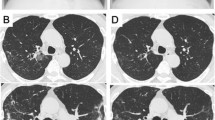Abstract
Mycobacterium avium (Mav) lung infections, called nodular-bronchiectasis (NB)-type M. avium complex (MAC) disease, are globally increasing. To elucidate whether there are unusual populations of Mav, causing NB-type disease rather than cavitary (CA)-type disease, we compared the virulence of Mav isolates from patients with NB-type (NB-Mav) and those from CA-type (CA-Mav) diseases, based on intracellular growth in various types of human cells. Five strains each of NB-Mav and CA-Mav were compared with each other for their invasiveness and ability to intracellularly replicate in various types of cultured cells of human origin. The two types of Mav isolates showed a similar ability, on average, to replicate in macrophages and lung epithelial cells. Moreover, they showed a similar ability to induce the production of reactive nitrogen intermediates and reactive oxygen intermediates by macrophages and susceptibility to antimicrobial molecules. Therefore, it appears that there is no essential difference in virulence in terms of infectivity to human macrophages and lung cells between Mav strains isolated from NB-MAC disease and those from CA-MAC disease. These findings indicate the importance of further studies to elucidate the mechanism for the establishment of NB-type MAC diseases based on host immunological conditions rather than the pathogenic nature of MAC organisms themselves.



Similar content being viewed by others
References
Iseman MD (1989) Mycobacterium avium complex and the normal host: the other side of the coin. N Engl J Med 321:896–898
Prince DS, Peterson DD, Steiner RM et al (1989) Infection with Mycobacterium avium complex in patients without predisposing conditions. N Engl J Med 321:863–868
Reich JM, Johnson RE (1992) Mycobacterium avium complex pulmonary disease presenting as an isolated lingular or middle lobe pattern. The Lady Windermere syndrome. Chest 101:1605–1609
Okumura M, Iwai K, Ogata H et al (2006) Clinical studies on the pathogenetic factors of cavitary and nodular bronchiectatic types in pulmonary Mycobacterium avium complex disease. J Jap Respir Soc 44:3–11
Okumura M, Iwai K, Ogata H et al (2008) Clinical factors on cavitary and nodular bronchiectatic types in pulmonary Mycobacterium avium complex disease. Intern Med 47:1465–1472
Falkinham JO 3rd, Iseman MD, de Haas P et al (2008) Mycobacterium avium in a shower linked to pulmonary disease. J Water Health 6:209–213
Wallace RJ Jr, Zhang Y, Brown-Elliott BA et al (2002) Repeat positive cultures in Mycobacterium intracellulare lung disease after macrolide therapy represent new infections in patients with nodular bronchiectasis. J Infect Dis 186:266–273
Inagaki T, Nishimori K, Yagi T et al (2009) Comparison of a variable-number tandem-repeat (VNTR) method for typing Mycobacterium avium with mycobacterial interspersed repetitive-unit-VNTR and IS1245 restriction fragment length polymorphism typing. J Clin Microbiol 47:2156–2164
Tomioka H, Sato K, Kajitani H et al (2000) Comparative antimicrobial activities of the newly synthesized quinolone WQ-3034, levofloxacin, sparfloxacin, and ciprofloxacin against Mycobacterium tuberculosis and Mycobacterium avium complex. Antimicrob Agents Chemother 44:283–286
Tomioka H, Sato K, Sano C et al (2002) Intramacrophage passage of Mycobacterium tuberculosis and M. avium complex alters the drug susceptibilities of the organisms as determined by intracellular susceptibility testing using macrophages and type II alveolar epithelial cells. Antimicrob Agents Chemother 46:519–521
Sato K, Tomioka H, Sano C et al (2003) Comparative antimicrobial activities of gatifloxacin, sitafloxacin and levofloxacin against Mycobacterium tuberculosis replicating within Mono Mac 6 human macrophage and A-549 type II alveolar cell lines. J Antimicrob Chemother 52:199–203
Akaki T, Sato K, Tomioka H et al (1997) Effector molecules in expression of the antimicrobial activity of macrophages against Mycobacterium avium complex: roles of reactive nitrogen intermediates, reactive oxygen intermediates, and free fatty acids. J Leukoc Biol 62:795–804
Akaki T, Tomioka H, Shimizu T et al (2000) Comparative roles of free fatty acids with reactive nitrogen intermediates and reactive oxygen intermediates in expression of the anti-microbial activity of macrophages against Mycobacterium tuberculosis. Clin Exp Immunol 121:302–310
Tomioka H, Sano C, Sato K et al (2005) Combined effects of ATP on the therapeutic efficacy of antimicrobial drug regimens against Mycobacterium avium complex infection in mice and roles of cytosolic phospholipase A2-dependent mechanisms in the ATP-mediated potentiation of antimycobacterial host resistance. J Immunol 175:6741–6749
Reich JM, Johnson RE (1992) Mycobacterium avium complex pulmonary disease presenting as an isolated lingular or middle lobe pattern. The Lady Windermere syndrome. Chest 101:1605–1609
Wallace RJ Jr, Zhang Y, Brown BA et al (1998) Polyclonal Mycobacterium avium complex infections in patients with nodular bronchiectasis. Am J Respir Crit Care Med 158:1235–1244
Kim RD, Greenberg DE, Ehrmantraut ME et al (2008) Pulmonary nontuberculous mycobacterial disease: prospective study of a distinct preexisting syndrome. Am J Respir Crit Care Med 178:1066–1074
Bobadilla JL, Macek M Jr, Fine JP et al (2002) Cystic fibrosis: a worldwide analysis of CFTR mutations—correlation with incidence data and application to screening. Hum Mutat 19:575–606
Anzai C, Morokawa N, Okada H et al (2003) CFTR gene mutations in Japanese individuals with congenital bilateral absence of the vas deferens. J Cyst Fibros 2:14–18
Author information
Authors and Affiliations
Corresponding author
Rights and permissions
About this article
Cite this article
Tatano, Y., Yasumoto, K., Shimizu, T. et al. Comparative study for the virulence of Mycobacterium avium isolates from patients with nodular-bronchiectasis- and cavitary-type diseases. Eur J Clin Microbiol Infect Dis 29, 801–806 (2010). https://doi.org/10.1007/s10096-010-0930-2
Received:
Accepted:
Published:
Issue Date:
DOI: https://doi.org/10.1007/s10096-010-0930-2




